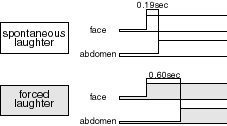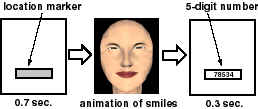Analysis of Laugh
Abstract
The purpose of our research is to investigate the mechanism behind
human communication. Among various factors,
laugh is said to be an emotional expression unique to mankind,
and is an essential factor in facilitating smooth communication.
We have focused on laugh, and are investigating the mechanism of laugh
quantitatively.
Effect of attention on classification of smiles
In our previous work, we found that temporal differences of eye and
mouth movements in facial expressions of smiles affect the
classification of smiles [1].
While thinking this was because subjects were paying attention to some
specific part of the face, we carried out an experiment for verification
purpose [2].
Several animations of smiling faces were created, each differing only in the
starting time of eye motion and mouth motion.
Prior to each animation, a location marker was displayed
for 0.7 sec. at either the position of the eyes or mouth. Then, after the
animation ended, a 5-digit random number was displayed for 0.3
sec. at the same position as the marker. Subjects were asked to classify
each smile, and to write down the displayed number.
As a result, we found that when subject's attention was forced to the
mouth, the ratio to classify smiles as pleasant ones raised
significantly.
Analysis of forced laughter in time differences of facial and abdominal
movements

Fig 2:
Time differences of reactions
in both types of laughter
|
There are two typical kinds of laughters; spontaneous laughter by
something humorous and forced laughter to maintain a social relationship.
We have clarified properties for characterizing these two types of
laughter [3].
Laughter was analyzed when subjects (five males and ten females)
were watching comical movies.
Among various expressions of laughter, we analyzed abdominal movements
in addition to facial expressions (movements of the eyes and mouth).
Surface EMG (electromyography) signals of the eye and mouth movements,
and abdominal movements (using a strain gauge around each subject's
abdomen) were measured.
As a result, we found that abdominal reactions to forced laughter are
later than those to spontaneous laughter for males, but no significant
difference exists for females.
[1]
Nishio, S. and Koyama, K.:
A Criterion for Facial Expression of Laugh Based on Temporal Difference
of Eye and Mouth Movement (in Japanese),
IEICE Trans. A, Vol.J80-A, No.8, pp. 1316-1318 (1997).
[2]
Nishio, S., Koyama, K. and Nakamura, T.:
Temporal Differences in Eye and Mouth Movements Classifying
Facial Expressions of Smiles,
Proc. 3rd IEEE International Conference on Automatic Face and Gesture
Recognition pp. 206-211 (1998).
[3]
Nakamura, T., Koyama, K., and Nishio, S.:
Analysis of ``Laughter of Claque'' in time differences of facial and
abdominal movements (in Japanese),
Proc. 5th Annual Convention of Japan Society for Research on Emotions,
p. 17 (1997).
Copyright(C) 1998 Nippon Telegraph and Telephone Corporation
Last modified on
31/Mar/2000


